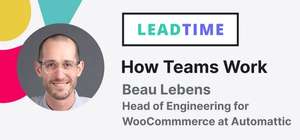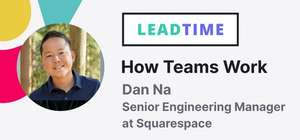Leading a team, especially a distributed or growing one, can be hard. Oftentimes the best advice and ideas come from other teams just like yours. That’s why we launched Lead Time: How Teams Work. This blog series profiles real teams, how they’re structured, and how they communicate through meetings and other touchpoints. Plus, each article features a top-notch leader who's got proven tips and real stories to learn from.
Meet Chris Bee, CTO at Lessen
Chris is CTO at Lessen, leading the company’s product, engineering, and design org. They’re a remote-first company with a hybrid culture. Teammates in Scottsdale, Seattle, and Miami come into local offices two days a week, and some folks work fully remote 100% of the time.
We sat down with Chris to learn about his approach to remote and hybrid information-sharing, process, and meetings.
How the team works
Team structure
Chris’s product, eng, and design teams are arranged in a functional organization style — with design reporting up into a design leader, product into a product leader, and engineering reporting into three vertical leaders. These leaders report directly to Chris.
The org as a whole is divided up into three product verticals too: client experience, vendor experience, and internal tooling/platform. Each of those teams currently consists of 10-30 members and they’re growing fast, looking to nearly triple in size in the next 6 months.
Team meetings and communication cadence
Here’s what a typical week on Chris’s team might look like in terms of meetings and async communication touchpoints.
“I've thought a lot about this over the years,” shares Chris. “I’ve experimented with a lot of different approaches, borrowed some best practices from others, and melded them together into this recipe that we follow here at Lessen.”

Daily:
- Vertical stand-ups: Each vertical team holds its own daily stand-up to share progress on in-flight work and raise flags or blockers. Sometimes these are done in-person or over video, and sometimes they happen asynchronously.
Weekly:
- Product roadmap meeting: Following the Monday sprint planning meetings, Chris, the functional and vertical leaders, and the product managers meet on Tuesdays to look at the product roadmap and priorities. Chris describes this meeting as “the heart of Lessen’s product operations.'' During the meeting, each PM will give a brief overview of the projects their team is working on for that sprint. As a group, they review dates and commitments and discuss opportunities for cross-functional collaboration. Sometimes, this meeting is also used for leadership updates or feedback sessions, where Chris asks questions and probes a bit deeper with the teams.
- Product roadmap async updates: Each vertical team is expected to update the product roadmap spreadsheet prior to the meeting. This helps inform a more robust discussion and gives the PMs time to think through what they’ll be sharing for their updates to make things more deliberate.
- Demo: The team also has a weekly demo on Tuesdays. It’s a chance for engineers to present the work they’ve been doing to leadership across the company (the attendee list is usually 50+ people).
- Customer experience syncs: Twice a week, the tech team meets folks in Lessen’s customer-facing operations team to exchange cross-functional information about the customer experience. They use this time to get input from customers on what is and isn’t working and to touch base on issues or rollout challenges for new features.
- Rotating sprint review sessions: The team holds a standing review session each week — which rotates between PRD (product requirements doc) review and UX design review.
Bi-weekly:
- Sprint planning: The vertical teams hold a planning meeting to map out the sprint ahead. They work in two-week sprints, so this happens every other Monday.
“It’s an opportunity for us to really dive in, challenge assumptions, understand requirements, give input, and eventually settle on something we can ship together. It’s a nice touchpoint to center us back in collaboration mode,” shares Chris.
Chris’s top tips for leading a hybrid org
1. Structure + autonomy = the magic combination
One of the biggest challenges for any team (especially remote ones) is getting accountability right.
No leader sets out to micromanage their team. In fact, most want to empower their teams with space and decision-making power to operate autonomously. But when you’re not sitting in the same office every day, it naturally becomes harder to keep tabs on in-flight work and hints of micromanagement can start to slip in.
One way Chris has worked to prevent this from happening on his team is by establishing clear goals and expectations that the whole team can align on.
“I’ve found that, as a leadership group, if we align on clear goals at the onset of a quarter or project we can then allow the teams to figure out how to achieve those goals themselves,” says Chris.
Not only does this give the teams more space to operate autonomously, but it also helps the vertical teams stay nimble (since they don’t need to run every decision by leadership) and gets everyone more fired up about the work (since they’re empowered to decide what they do and don’t take on).
To ensure work doesn’t happen in a vacuum, Chris has also focused on building out some clear structures and touchpoints to hold the team accountable to their commitments.
Some of the structures Chris has put in place for teamwide accountability include:
Regular cadence for checking in around the work
- The team knows when to share status updates and what each one should include — this stays the same week over week so there are no surprises.
- Weekly product roadmap meetings with very clear reporting structures
- Weekly demos where the eng team shows new work — Chris says this is a fun moment for the whole team that also serves as a “forcing function to get things working and demo-able”
Clear roles and responsibilities for projects and meetings
- Who’s expected to attend, what attendance looks like (participation, presentation, etc.)
- Clear project owners who report on the work
“It’s all about setting expectations so we’re not making asks of people ad hoc,” says Chris.
“That’s the worst — getting bombarded with requests that you weren't expecting… somebody needs something tomorrow and suddenly you’re scrambling to whip together a status report that may not be that comprehensive. Having a set cadence helps prevent this from happening.”
2. Build deliberateness into your meeting and planning culture
Chris has also worked to establish a clear structure around meetings and planning moments at Lessen.
“Things like quarterly planning, annual planning, OKRs — we've been really deliberate about that. I’ve found that people tend to be pretty open to adding process and structure to these things that could normally be done in a lot of different ways.”
Uniting around a structure for these big moments has helped Chris’s team actually get to the work and make decisions, instead of churning around how to do it. He says you’ve got to start somewhere, and even if some team members don’t fully agree with the chosen structure, “most are open to at least trying it, making tweaks, and modifying.”
For meetings, Chris has worked to find a way to ensure the right folks are included in every discussion and everyone can be looped in after the fact — without putting the whole team in back-to-back meetings each week.
“You want to be transparent and give people lots of background info, but in the same breath, you can't have the whole company attend every single meeting. So, how do you do that and make it effective?”
Chris says a few things have helped his team lessen their meeting load and still feel informed and aligned.
- Creating a deliberate framework around who attends what meetings
- Adopting a structured meeting notes format for every meeting, so folks who don’t attend can easily find the takeaways and decision-points from any given meeting
- Strengthening the team’s async communication practices, like written updates and clear, robust product requirements documentation
“Being deliberate about some of these things is important because otherwise people can feel like they missed out or feel like they should be invited to something and they weren't. Or on the flip side, people attend and it feels like we’re wasting their time,” shares Chris.
3. Take a pause together at the start of each week
One last tip from Chris: in the hustle and bustle of the typical workweek grind, it’s important to prioritize time to connect as a team. An easy way Chris builds this into his team’s week is through “morning coffee” together every Monday at 9am.
“There's only one rule,” he says. “You're not allowed to talk about work. It's just an hour of just truly intentional water cooler talk. What we did over the weekend, how we’re feeling, that kind of thing.”
Starting the week off in this way helps Chris set an important tone for the team. It shows that connection and camaraderie is just as important a priority as the work itself. It helps folks see and acknowledge their teammates, not just for the work they do, but for who they are as a people.
All this helps to build empathy and connection, and strengthen teamwork across the org.
Kick off your Mondays with connection using our big book of team-building questions







